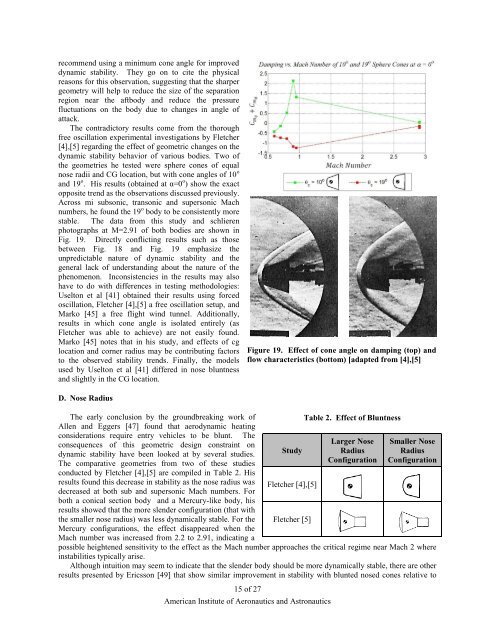Survey of Blunt Body Dynamic Stability in Supersonic Flow
Survey of Blunt Body Dynamic Stability in Supersonic Flow
Survey of Blunt Body Dynamic Stability in Supersonic Flow
You also want an ePaper? Increase the reach of your titles
YUMPU automatically turns print PDFs into web optimized ePapers that Google loves.
ecommend us<strong>in</strong>g a m<strong>in</strong>imum cone angle for improved<br />
dynamic stability. They go on to cite the physical<br />
reasons for this observation, suggest<strong>in</strong>g that the sharper<br />
geometry will help to reduce the size <strong>of</strong> the separation<br />
region near the aftbody and reduce the pressure<br />
fluctuations on the body due to changes <strong>in</strong> angle <strong>of</strong><br />
attack.<br />
The contradictory results come from the thorough<br />
free oscillation experimental <strong>in</strong>vestigations by Fletcher<br />
[4],[5] regard<strong>in</strong>g the effect <strong>of</strong> geometric changes on the<br />
dynamic stability behavior <strong>of</strong> various bodies. Two <strong>of</strong><br />
the geometries he tested were sphere cones <strong>of</strong> equal<br />
nose radii and CG location, but with cone angles <strong>of</strong> 10 o<br />
and 19 o . His results (obta<strong>in</strong>ed at α=0 o ) show the exact<br />
opposite trend as the observations discussed previously.<br />
Across mi subsonic, transonic and supersonic Mach<br />
numbers, he found the 19 o body to be consistently more<br />
stable. The data from this study and schlieren<br />
photographs at M=2.91 <strong>of</strong> both bodies are shown <strong>in</strong><br />
Fig. 19. Directly conflict<strong>in</strong>g results such as those<br />
between Fig. 18 and Fig. 19 emphasize the<br />
unpredictable nature <strong>of</strong> dynamic stability and the<br />
general lack <strong>of</strong> understand<strong>in</strong>g about the nature <strong>of</strong> the<br />
phenomenon. Inconsistencies <strong>in</strong> the results may also<br />
have to do with differences <strong>in</strong> test<strong>in</strong>g methodologies:<br />
Uselton et al [41] obta<strong>in</strong>ed their results us<strong>in</strong>g forced<br />
oscillation, Fletcher [4],[5] a free oscillation setup, and<br />
Marko [45] a free flight w<strong>in</strong>d tunnel. Additionally,<br />
results <strong>in</strong> which cone angle is isolated entirely (as<br />
Fletcher was able to achieve) are not easily found.<br />
Marko [45] notes that <strong>in</strong> his study, and effects <strong>of</strong> cg<br />
location and corner radius may be contribut<strong>in</strong>g factors<br />
to the observed stability trends. F<strong>in</strong>ally, the models<br />
used by Uselton et al [41] differed <strong>in</strong> nose bluntness<br />
and slightly <strong>in</strong> the CG location.<br />
Figure 19. Effect <strong>of</strong> cone angle on damp<strong>in</strong>g (top) and<br />
flow characteristics (bottom) [adapted from [4],[5]<br />
D. Nose Radius<br />
The early conclusion by the groundbreak<strong>in</strong>g work <strong>of</strong><br />
Allen and Eggers [47] found that aerodynamic heat<strong>in</strong>g<br />
considerations require entry vehicles to be blunt. The<br />
consequences <strong>of</strong> this geometric design constra<strong>in</strong>t on<br />
dynamic stability have been looked at by several studies.<br />
The comparative geometries from two <strong>of</strong> these studies<br />
conducted by Fletcher [4],[5] are compiled <strong>in</strong> Table 2. His<br />
results found this decrease <strong>in</strong> stability as the nose radius was<br />
decreased at both sub and supersonic Mach numbers. For<br />
both a conical section body and a Mercury-like body, his<br />
results showed that the more slender configuration (that with<br />
the smaller nose radius) was less dynamically stable. For the<br />
Mercury configurations, the effect disappeared when the<br />
Mach number was <strong>in</strong>creased from 2.2 to 2.91, <strong>in</strong>dicat<strong>in</strong>g a<br />
possible heightened sensitivity to the effect as the Mach number approaches the critical regime near Mach 2 where<br />
<strong>in</strong>stabilities typically arise.<br />
Although <strong>in</strong>tuition may seem to <strong>in</strong>dicate that the slender body should be more dynamically stable, there are other<br />
results presented by Ericsson [49] that show similar improvement <strong>in</strong> stability with blunted nosed cones relative to<br />
15 <strong>of</strong> 27<br />
Study<br />
Fletcher [4],[5]<br />
Fletcher [5]<br />
American Institute <strong>of</strong> Aeronautics and Astronautics<br />
Table 2. Effect <strong>of</strong> <strong>Blunt</strong>ness<br />
Larger Nose<br />
Radius<br />
Configuration<br />
Smaller Nose<br />
Radius<br />
Configuration
















